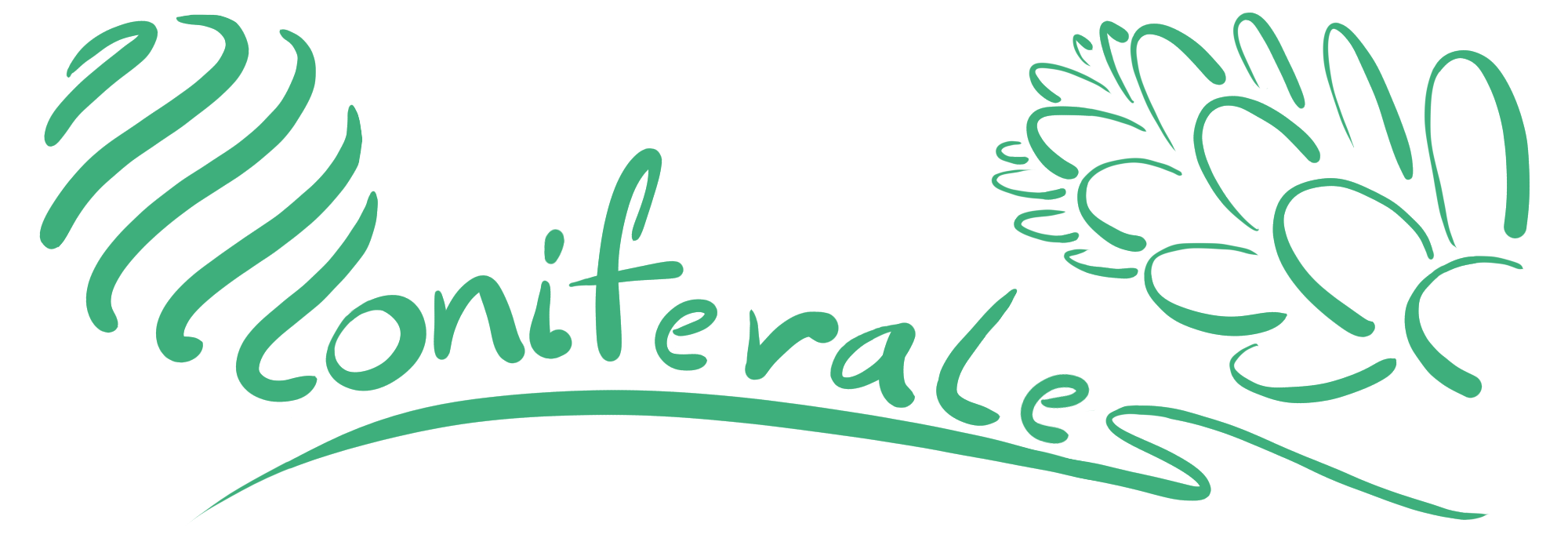Pinaceae Abies forrestii var. forrestii Coltm.-Rog.
Etymology
Abies refers to ‘to rise’; indicating large trees.
forrest refers to the plant hunter George Forrest.
Colloquial Name
Forrest’s fir
Description
These trees can grow up to 40 meters tall, with a straight, column-like trunk that remains unbranched until higher up, forming a broad conical crown. In older trees, the top flattens out. The bark starts off smooth and brownish-gray but becomes dark brown and develops fissures near the base as the tree ages.
The main branches are long and spread outward, though near the top, they angle slightly upward. Smaller branches grow in an upward direction. The young twigs are thick and can range in color from purplish to reddish or even orange-brown, eventually turning gray. Their surface is smooth or finely grooved and completely hairless. The scars left by fallen needles are circular or oval.
The buds are small and rounded to oval in shape, measuring between 4 and 10 millimeters long and 3 to 7 millimeters wide. They are covered in a thick layer of sticky resin. The bud scales are reddish-brown and coated with white resin, and they stay on the tree for several years. The needles grow densely in a spiral pattern along the shoots, forming several overlapping ranks that separate slightly in the middle. On branches that bear cones, the needles angle upward. They are usually between 1.5 and 4 centimeters long and 2 to 2.5 millimeters wide, curving or twisting slightly at the base. They are narrow and flat, with margins that are either straight or slightly curled downward. The upper surface is glossy and dark green or bluish-green, while the underside has two pale white or greenish-white bands. The tips of the needles are usually notched, though those on cone-bearing branches may taper to a sharp point. The undersides have two bands of stomata separated by a green central ridge. Small resin canals run along the edges of the needles.
The pollen cones grow laterally along the branches and measure 3 to 4.5 centimeters long. They are yellowish in color with small purple structures that produce pollen. The seed cones are also lateral, growing upright on short stalks. They are thick and either barrel-shaped or cylindrical, with a rounded or slightly indented tip. When young, they are purplish-blue with blue bracts but mature to a deep purplish-brown or dark brown. The central cone axis remains after the seeds are released, forming a thick, tapered, purplish-brown structure.
The cone scales are wedge-shaped and slightly wider toward the tip, measuring around 2 centimeters long and 1.8 centimeters wide at the middle of the cone. Their surface is usually smooth but may be slightly rough, with fine hairs on exposed areas. The upper edges are either smooth or slightly irregular, while the base narrows into a short stalk. The bracts, which are small leaf-like structures between the cone scales, vary in how much they extend beyond the cone. In some cases, only the tips protrude, while in others, they are fully included within the cone. Occasionally, they extend slightly beyond the cone scales.
The seeds are about 8 millimeters long and have a glossy brown surface. They are attached to broad, wedge-shaped wings that measure around 10 by 8 millimeters and are light brown in color.
Subordinate Taxa
There exist 4 subordinate taxa for Abies forrestii:
- Abies forrestii var. ferreana
- Abies forrestii var. forrestii
- Abies forrestii var. georgei
- Abies forrestii var. smithii
Distribution
This map shows botanical records (points) for this taxon. By opening the map’s sidebar (collapsed by default) you can toggle visibility or change the basemap. By clicking on records, you reveal more information.
TDWG Codes
3, 36, CHC, CHC-SC, CHC-YN, CHT
Habitat
The natural habitats for Abies forrestii var. forrestii are temperate forests. It is naturally found at an elevation of at least 2400 up to 3800 metres. Other conifers associated with Abies forrestii var. forrestii are:
USDA Hardiness zone – 7
Abies forrestii var. forrestii is hardy to USDA Zone 7 (Bannister & Neuner, 2001), meaning its frost tolerance lies somewhere in the range of -17.8C (0F) to -12.2C (10F).
Species Continuity
The population trend for Abies forrestii var. forrestii is decreasing. There are ongoing threats for Abies forrestii var. forrestii and they are listed as follows:
IUCN Category – LC
According to the IUCN Red List, Abies forrestii var. forrestii has been assigned the status of LC(Least Concern). This means that according to the Red List criteria, this species is not qualified as threatened.
Superordinate Taxa
The nearest superordinate taxon for Abies forrestii is Subsect. Delavayianae. The coordinate taxa for Abies forrestii are therefore:
- Abies delavayi
- Abies densa
- Abies fabri
- Abies fanjingshanensis
- Abies fargesii
- Abies spectabilis
- Abies yuanbaoshanensis
Abies forrestii var. forrestii is further placed under Abietoideae. Abies forrestii var. forrestii is also placed under Pinaceae.
This map shows botanical records (points) for this taxon. By opening the map’s sidebar (collapsed by default) you can toggle visibility or change the basemap. By clicking on records, you reveal more information.



Reviews
There are no reviews yet.